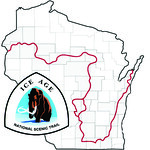Bring a compass and tapemeasure.
Wetlands are areas that are inundated or saturated by surface or ground water which supports vegetation adapted to such conditions. They vary widely because of regional and local differences in soils, topography, climate, hydrology, water chemistry, vegetation, and other factors. Wetlands are a link or transition zone between land and water where water flow, nutrient cycling, and energy from the sun combine to produce a unique ecosystem, providing habitat for thousands of species of aquatic and terrestrial plants and animals.
There are four general categories of wetlands in the United States including; marshes, swamps, bogs, and fens. Swamps are forested wetlands with very low topographic relief and often found near rivers or lakes with the presence of water tolerant trees and bushes. Swamps often have poor drainage and waterlogged soil. The mineral supply is high enough to stimulate decay of organisms and prevent the accumulation of organic materials.
Swamps and other wetland had a reputation of being unproductive land with low property value. They are now considered critically important in the process of providing fresh water and a breeding ground for a wide variety of life. Government agencies are taking steps to protect and preserve swamps and other wetlands.
Dead plant matter settles in the water where the decay process uses up the oxygen supply. Under these conditions, the decay of organic matter is incomplete and that causes “swamp water” varying from yellow to deep brown. A swamp with a good water source and little disturbance can exist longer than a mountain range. Yet when a swamp dries up, it is rapidly swallowed up by the surrounding landscape. You will also notice that most of the trees appear to be on clumps of higher ground, which in most cases if formed by trees and roots. Many of the seedlings sprout on fallen down logs or stumps out of the water. Over time the roots from many plants create the mounds.
Along this part of Lake Michigan the landscape has ridges and swales that were created by the receding edges a glacial lake. (See GC340N1 – Shrinking of Lake Nipissing; located in Point Beach.) These ridges and swales run parallel to the shoreline. In the lower swale areas, wetlands often form. Water enters this swamp from a stream on the west side. It is part of a large wetland ecosystem that stretches from Two Rivers north of the School Forest.
The posts for the boardwalk are placed on buried pans to prevent them from sinking because solid ground is too far below the surface. This also eliminates the use of cement in this sensitive environment. After the snow melts in the spring and heavy rains, the water level can reach up to the boardwalk and the water will actually flow. In drier times, there may be no visible water. The high water level marks can be seen on the tree trunks. As of 2012, the swamp’s tree species are: black ash, green ash, elm, white birch, silver maple, yellow birch, and cedar. This may change over time with the introduction of invasive species.
 IATCC is the cache designation to highlight a series of EarthCaches along the Ice Age National Scenic Trail grouped into a special category called "ColdCache."
IATCC is the cache designation to highlight a series of EarthCaches along the Ice Age National Scenic Trail grouped into a special category called "ColdCache."
The Ice Age Trail is one of eleven National Scenic Trails designated by the National Park Service. This unique trail is entirely within the state of Wisconsin and follows along the terminal moraine of the most recent glacier which retreated about 10,000 years ago.
This project is supported by the Ice Age Trail Alliance (IATA). The goal is to bring more visitors to the trail and promote public awareness, appreciation, and understanding of Wisconsin’s glacial landscape.
The IATA has created an awards program to encourage visits to the trail and ColdCache sites. This awards program is separate from, and in addition to, any other Geo- or EarthCache awards program.
A current list of approved ColdCache sites can be found on the “IATCC Bookmark List”. More information on the Ice Age Trail Atlas, the Companion Guide, the ColdCache Project and Awards Program can be found on the “ColdCache Webpage”
Permission
The ColdCache Placement Form has been submitted to Mark Swanson of the Manitowoc Rahr Memorial School Forest.
Resources
Britannia
Environmental Protection Agency
Fantasymaps
Rahr Memorial School Forest History by Eugene Krejcarek
Swamps – Nature Works
Wikipedia
To claim this find:
1) How high is the high water mark on the tree trunks around the platform?
2) If you happen to be here when the water is actually moving, what direction does it flow?
3) Imagine that the stream on the west side was diverted or dried up and no longer provided new water to the swamp. What do you think would happen?